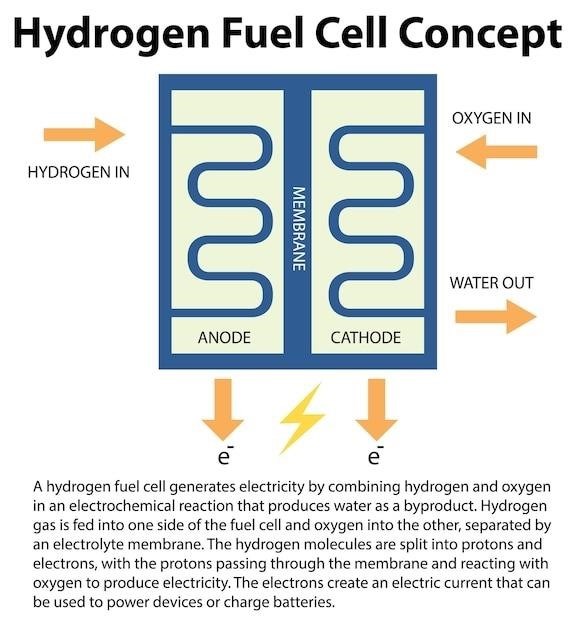Hayward Salt Cell Manual⁚ A Comprehensive Guide
This comprehensive guide provides a detailed overview of Hayward salt cells, covering topics ranging from their functionality and types to setup, maintenance, troubleshooting, and safety precautions. This manual is designed to help you understand and effectively operate your Hayward salt cell, ensuring a clean and healthy swimming pool environment.
Introduction
Welcome to the world of salt chlorination! This manual serves as your comprehensive guide to understanding and utilizing Hayward salt cells, the heart of your pool’s sanitation system. Hayward, a leading name in pool equipment, offers a range of salt cells designed to provide clear, soft water, making your swimming experience more enjoyable and hassle-free.
Salt chlorination systems have revolutionized pool maintenance by offering a more natural and convenient alternative to traditional chlorine methods. By converting salt into chlorine, these systems eliminate the need for harsh chemicals and the associated handling and storage concerns. This manual will delve into the inner workings of Hayward salt cells, explaining how they generate chlorine, the different types available, and how to maintain them for optimal performance.
Whether you’re a seasoned pool owner or a first-time buyer, this manual will equip you with the knowledge and skills to effectively operate your Hayward salt cell. From setup and configuration to troubleshooting common issues and ensuring safety, we’ve covered every essential aspect.
Let’s dive in and explore the world of Hayward salt cells, unlocking the key to a cleaner, healthier, and more enjoyable swimming experience!
Understanding the Hayward Salt Cell
At the core of your Hayward salt chlorination system lies the salt cell, a vital component responsible for generating chlorine from the dissolved salt in your pool water. It’s a marvel of electrochemical engineering, silently working to keep your pool clean and sanitized.
The Hayward salt cell operates on the principle of electrolysis. A low-voltage electrical current is passed through the cell, which contains two electrodes⁚ an anode and a cathode. The salt in the water is drawn to the electrodes, where it undergoes a chemical reaction. At the anode, the salt is oxidized, producing chlorine gas. This chlorine then dissolves in the water, providing the sanitation that keeps your pool sparkling clean.
The Hayward salt cell is designed for efficiency and convenience. It automatically generates chlorine as needed, eliminating the need for manual chemical additions. This ensures consistent sanitation levels and reduces the hassle of maintaining your pool. The cell itself is typically made of durable materials, including titanium, to resist corrosion and ensure long-lasting performance.
Understanding the basic workings of your Hayward salt cell is essential for effective pool maintenance. By understanding how the cell generates chlorine and the factors that can affect its performance, you can proactively address any issues and ensure your pool remains pristine and safe for swimming.
Types of Hayward Salt Cells
Hayward offers a diverse range of salt cells designed to cater to various pool sizes and needs. Each type is engineered with specific features and capabilities to ensure optimal performance and longevity. Here’s a breakdown of the common Hayward salt cell types⁚
- T-CELL-9⁚ This cell is designed for pools up to 25,000 gallons and features a compact design, making it suitable for smaller pools or those with limited space.
- T-CELL-15⁚ This cell is a larger option, suitable for pools up to 40,000 gallons. It offers increased chlorine production capacity, ideal for larger pools or those with higher usage.
- GLX-CELL-9-W⁚ This cell is a high-output option designed for pools up to 25,000 gallons. It provides increased chlorine production capabilities, particularly beneficial for pools exposed to heavy usage or harsh environmental conditions.
- GLX-CELL-15-W⁚ This cell is a high-output option for pools up to 40,000 gallons. It offers even greater chlorine production capacity, ideal for larger pools or those with high usage and challenging water conditions.
- TCELL925⁚ This cell is a high-performance option designed for pools up to 25,000 gallons. It features extended life capabilities, reducing the frequency of replacements.
- TCELL940⁚ This cell is designed for pools up to 40,000 gallons and offers extended life capabilities, providing long-term chlorine production with minimal maintenance.
When choosing the right Hayward salt cell for your pool, consider factors such as pool size, water volume, usage frequency, and desired chlorine production levels. Consulting with a pool professional can help you determine the optimal cell type to meet your specific requirements.

Setting Up Your Hayward Salt Cell
Installing and setting up your Hayward salt cell correctly is crucial for its proper function and optimal chlorine production. This section provides step-by-step instructions to guide you through the process.
- Locate the Salt Cell⁚ Choose a suitable location for your salt cell, ensuring it’s easily accessible for maintenance and inspections. Avoid placing it in direct sunlight or areas prone to freezing temperatures.
- Install the Salt Cell⁚ Follow the manufacturer’s instructions for installing the salt cell. This typically involves connecting it to the pool’s plumbing system and ensuring proper flow rates.
- Configure the Controller⁚ Your Hayward salt cell controller needs to be configured for the specific cell type you’ve installed. Refer to your controller’s manual for detailed instructions on setting the cell type and other parameters.
- Add Salt to the Pool⁚ Before starting your salt chlorination system, ensure your pool water has the correct salt concentration. Refer to the manufacturer’s recommendations for the ideal salt level (typically 1200-1800 ppm) and use a test kit to measure the salt concentration.
- Power On and Start⁚ Once the salt level is correct, power on your salt cell system and allow it to run for a few hours to establish proper chlorine production.
- Monitor and Adjust⁚ Regularly monitor your pool water chemistry, including chlorine levels, pH, and alkalinity. Adjust the salt cell’s settings as needed to maintain proper water balance.
If you’re unsure about any aspect of the installation or setup process, it’s recommended to consult with a qualified pool technician. They can provide expert guidance and ensure your salt cell system is properly installed for optimal performance.
Maintaining Your Hayward Salt Cell
Regular maintenance is essential for ensuring the longevity and efficiency of your Hayward salt cell. A well-maintained salt cell will consistently produce chlorine, keeping your pool water clean and safe. Here’s a breakdown of essential maintenance tasks⁚
- Inspect Regularly⁚ Visually inspect your salt cell periodically for any signs of damage, corrosion, or mineral buildup. This includes checking the cell’s housing, connections, and the electrode plates.
- Clean the Salt Cell⁚ Depending on your pool’s usage and water conditions, your salt cell may require cleaning every few months. Follow the manufacturer’s instructions for cleaning the cell, which typically involves soaking it in a cleaning solution to remove mineral deposits.
- Monitor Salt Levels⁚ Regularly test the salt level in your pool water. A low salt level can reduce chlorine production. Add salt as needed to maintain the optimal salt concentration recommended by the manufacturer.
- Check Flow Rate⁚ Ensure proper water flow through the salt cell. A low flow rate can hinder chlorine production. If you notice a reduction in flow, check for any blockages in the plumbing system.
- Maintain Water Chemistry⁚ Regularly test and adjust your pool’s water chemistry, including pH, alkalinity, and calcium hardness. Maintaining proper water balance prevents mineral buildup on the salt cell and enhances its performance.
- Service the Controller⁚ Refer to the controller’s manual for maintenance instructions. This may involve cleaning the controller’s display, checking connections, and updating the firmware.
By adhering to these maintenance practices, you can extend the lifespan of your Hayward salt cell, minimize the need for repairs, and ensure your pool’s water quality remains consistently clean and safe. If you encounter any issues or have concerns about your salt cell’s performance, don’t hesitate to contact a qualified pool professional for assistance.
Troubleshooting Common Hayward Salt Cell Issues
While Hayward salt cells are generally reliable, issues can arise. Here’s a guide to troubleshooting common problems and potential solutions⁚

- Low Chlorine Production⁚ This could be due to low salt levels, a dirty salt cell, a malfunctioning controller, or a reduced water flow rate. Check the salt level, clean the cell, inspect the controller for error codes, and ensure proper water flow through the system.
- Error Codes⁚ Your Hayward salt cell controller may display error codes indicating specific problems. Refer to the controller’s manual for a detailed explanation of the error codes and recommended troubleshooting steps.
- Salt Cell Not Turning On⁚ Check if the power supply to the salt cell is working. Inspect the circuit breaker and fuses, ensuring they are not tripped. Verify that the controller is switched on and properly configured.
- Inaccurate Salt Readings⁚ If your controller displays inaccurate salt readings, it could be due to a faulty sensor, a dirty salt cell, or a problem with the controller’s calibration. Clean the cell, check the sensor for damage, and consider recalibrating the controller.
- High Salt Cell Temperature⁚ An excessively high salt cell temperature can indicate a blockage in the plumbing system, a malfunctioning pump, or a problem with the flow switch. Check for blockages, ensure the pump is operating correctly, and inspect the flow switch for proper functionality.
- No Flow LED Flashing⁚ This indicates a lack of water flow through the salt cell. Check for blockages in the plumbing system, ensure the pump is operating correctly, and verify that the flow switch is working.
If you are unable to resolve the issue after following these troubleshooting steps, contact a qualified pool professional for assistance. They can diagnose the problem accurately and provide appropriate solutions to restore your salt cell’s functionality.
Hayward Salt Cell Safety Precautions
While Hayward salt cells provide a safe and efficient way to sanitize your pool, it’s crucial to follow safety precautions to prevent accidents and ensure the well-being of everyone using the pool.
- Electrical Safety⁚ Always disconnect the power to the salt cell before performing any maintenance or repairs. Ensure that the electrical wiring is properly insulated and grounded to prevent electrical shocks. Never touch the salt cell while it is energized.
- Chemical Handling⁚ Salt cells use salt to produce chlorine, which is a powerful chemical. Exercise caution when handling salt and avoid contact with eyes or skin. Wear appropriate protective gear like gloves and goggles when handling salt.
- Water Safety⁚ Always supervise children around the pool and ensure they are aware of water safety rules. Never leave children unattended near the pool, and teach them how to swim. Install safety barriers to prevent unauthorized access to the pool area.
- Salt Cell Maintenance⁚ Regularly inspect the salt cell for signs of wear and tear, such as corrosion or cracks. Clean the salt cell according to the manufacturer’s instructions to prevent buildup and ensure proper functionality. Replace the salt cell when it reaches the end of its lifespan to maintain optimal performance and safety.
- Professional Installation⁚ Ensure that the salt cell is installed by a qualified pool professional. Incorrect installation can lead to safety hazards and damage to the system. Follow the manufacturer’s instructions for proper installation and connections.
By adhering to these safety precautions, you can minimize the risk of accidents and enjoy the benefits of a clean and healthy swimming pool environment.
Using Genuine Hayward Replacement Parts
When it comes to maintaining the performance and longevity of your Hayward salt cell, using genuine Hayward replacement parts is paramount. While the temptation to opt for cheaper, non-genuine alternatives might seem appealing, it’s crucial to understand the potential consequences.
Genuine Hayward parts are specifically designed and manufactured to meet the rigorous standards of your salt cell system. They are rigorously tested to ensure compatibility, durability, and optimal performance. Using non-genuine parts can lead to a number of issues, including⁚
- Reduced Efficiency⁚ Non-genuine parts may not be compatible with the salt cell’s internal components, leading to reduced chlorine production and a compromised sanitization process.
- Premature Failure⁚ Non-genuine parts often lack the quality and durability of genuine Hayward components, increasing the risk of premature failure and requiring costly replacements.
- Voiding Warranty⁚ Using non-genuine parts can void the warranty on your Hayward salt cell. This means you’ll be responsible for any repairs or replacements, even if the issue is related to the non-genuine part.
- Safety Hazards⁚ Non-genuine parts may not meet safety standards, potentially leading to electrical hazards or malfunctioning of the system, putting you and your loved ones at risk.
By investing in genuine Hayward replacement parts, you can ensure that your salt cell operates efficiently, safely, and with optimal performance, extending its lifespan and protecting your investment.
Hayward Salt Cell Warranty Information
Hayward stands behind the quality and reliability of its salt cells with comprehensive warranty coverage. Understanding the terms and conditions of your warranty is essential for protecting your investment and ensuring you receive the necessary support in case of any issues.
The specific warranty period and coverage details may vary depending on the model of your Hayward salt cell. You can find the detailed warranty information in the user manual provided with your salt cell or by visiting the Hayward website. Generally, Hayward salt cells come with a limited warranty that covers defects in materials and workmanship for a specified period, typically ranging from one to several years.
To ensure your warranty remains valid, it’s crucial to follow the recommended installation, operation, and maintenance procedures outlined in the user manual. Using genuine Hayward replacement parts is also essential for maintaining warranty coverage.
In case of a warranty claim, contact Hayward customer service with your salt cell’s model number, serial number, and a detailed description of the issue; They will guide you through the claim process and provide assistance in resolving the problem. Proper documentation and adherence to warranty guidelines will ensure a smooth and efficient resolution process.



